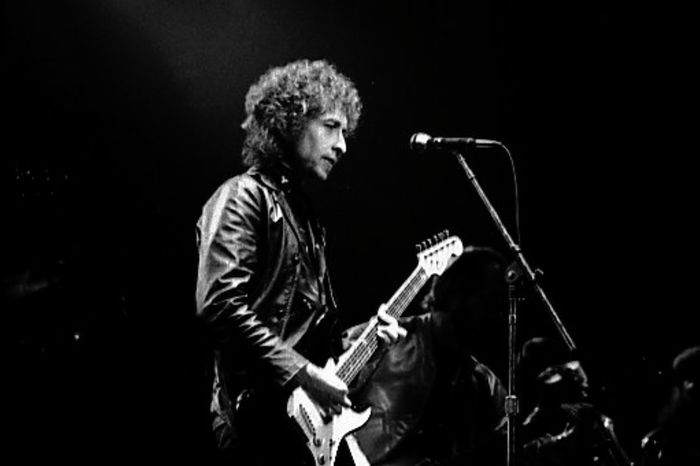Getting to know the Complete Unknown
As his biopic hits cinemas, Daniel Kamaluddin is here to explain the enigma that is Bob Dylan

The title of the recent Bob Dylan biopic, A Complete Unknown, is as close a definition as we can get for such an enigmatic character. With a career spanning six decades and forty studio albums, Dylan, born Robert Zimmerman, has reinvented himself countless times. The only musician to win the Nobel Prize for Literature, he has constantly, and consciously, evaded definition.
Under Woody Guthrie’s influence, he released a series of folk covers in his self-titled debut album. Since then, he has been a counterculture hero, the icon of the Baby Boomer generation, a prose poet, a rockstar, and gospel singer.
“With such characteristic volatility, navigating Dylan is no easy task”
A Complete Unknown, starring Timothée Chalamet as Bob Dylan, culminates in one such reinvention as Dylan appeared on stage at the Newport Folk Festival with an electric guitar, causing furore in the folk community. If Dylan’s elusion of genre is disorientating, his live shows are more so. Dylan began his so-called Never Ending Tour in 1988 and has since played 3,066 shows. Each night he reinvents his songs on stage, diverging from recordings, and rarely plays his greatest hits. With such characteristic volatility, navigating Dylan is no easy task.
Where better to start than with ‘Girl From the North Country’ from Dylan’s breakthrough album The Freewheelin’ Bob Dylan (1963), a folk classic with its rural American imagery. Inspired in part by visiting the UK, it fuses American folk tradition with an appreciation of English folk song. It entrancingly captures nostalgia for love lost with its mellow, undulating acoustic guitar and straightforward, beautiful lyrics.
Dylan’s masterpiece, ‘Like a Rolling Stone’ from Highway 61 Revisited (1965), marked his transformation into a rockstar. Dylan characteristically combines a deceptively simple three-chord chorus with complex, at times baffling, lyrics imbued with poetic sensibility. Dylan’s presentation of ‘Miss Lonely’ is at once full of both sympathy and bitterness, and unlike the romantic ‘Girl From the North Country’, ‘Like a Rolling Stone’ marks Dylan’s darker, more menacing side.
“‘Hurricane’ is not just a throwback to Dylan’s earlier protest music, it is angrier, more riotous, embodying his deeper fury at injustice”
‘Hurricane’ from Desire (1976), recaptures Dylan’s earlier love of protest songs. Written in outrage at the racist jury who wrongly convicted the boxer ‘Hurricane’ Carter, Dylan used his prominence to raise awareness of this miscarriage of justice and hosted a fundraising concert at Madison Square Garden. The song throws the listener into the moment of the murder and infuses them with his outrage through his fast pace and relentless chorus. ‘Hurricane’ is not merely a throwback to Dylan’s earlier protest music bur is angrier, and more riotous, embodying a deeper fury at injustice.
With a bouncy jazz rhythm and warm backing vocals, Dylan turns away from his folk roots on ‘Gotta Serve Somebody’ from Slow Train Coming (1979) - the first single of his Gospel period. It explains his newfound faith, not dogmatically, but by expressing his belief that worship is part of human nature and emphasising that people of every life experience feel this calling.
The much-covered ‘Make You Feel My Love’ from Time Out of Mind (1997) was the first Dylan song I ever heard, and is one of the greatest, most spine-tingling love songs ever written. Its gentle piano accompaniment combined with Dylan’s exquisite crooning vocals encapsulate intense longing. The lyrics are love poetry in their own right, with their soaring, cosmic imagery and vision of eternal love emerging from dark, stormy weather.
“The folk tradition from which Dylan emerged is less engaged with singular artistic talent but capturing ordinary people’s experiences in their own dialect”
While Dylan has often rejected definition, the kaleidoscopic nature of his music is explained not by a shallow desire to be a maverick, but a constant urge to evolve as an artist and seek new inspiration at every turn. The folk tradition from which Dylan emerged is less engaged with singular artistic talent but capturing ordinary people’s experiences in their own dialect. Through his creative openness, Dylan voices his generation, the oppressed, the beauty and pain of everyday romance.
Dylan has been defined by his enigma and his unpredictability; A Complete Unknown charts the creation and cultivation of this ever-changing persona. Few artists have as persistently frustrated the expectations of others, first confounding his folk devotees when he went electric, then his rock followers with his shift to gospel, and his gospel fans as he returned to folk. With each new album, and each night of his Never Ending Tour, Dylan follows where inspiration takes him, and that is why this complete unknown has become such a lasting success.
Want to share your thoughts on this article? Send us a letter to letters@varsity.co.uk or by using this form.
 News / Uni offers students £55k in payouts31 October 2025
News / Uni offers students £55k in payouts31 October 2025 News / Uni error forces deeper spending cuts31 October 2025
News / Uni error forces deeper spending cuts31 October 2025 News / College rowing captains narrowly vote to exclude trans women31 October 2025
News / College rowing captains narrowly vote to exclude trans women31 October 2025 News / Students launch women’s society excluding trans women31 October 2025
News / Students launch women’s society excluding trans women31 October 2025 News / Students allowed to use AI, says new uni guidance31 October 2025
News / Students allowed to use AI, says new uni guidance31 October 2025










